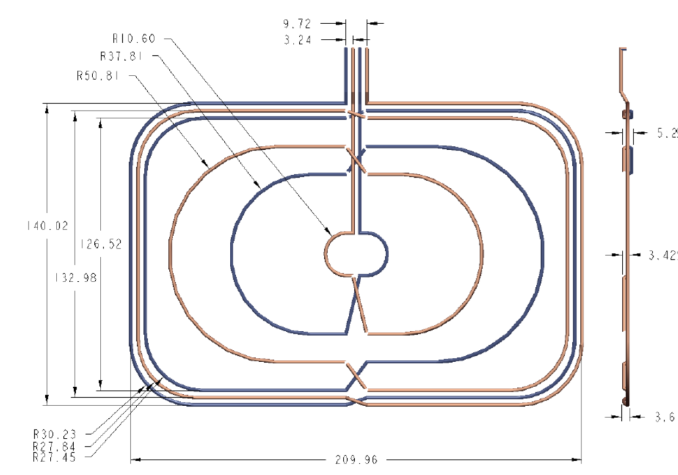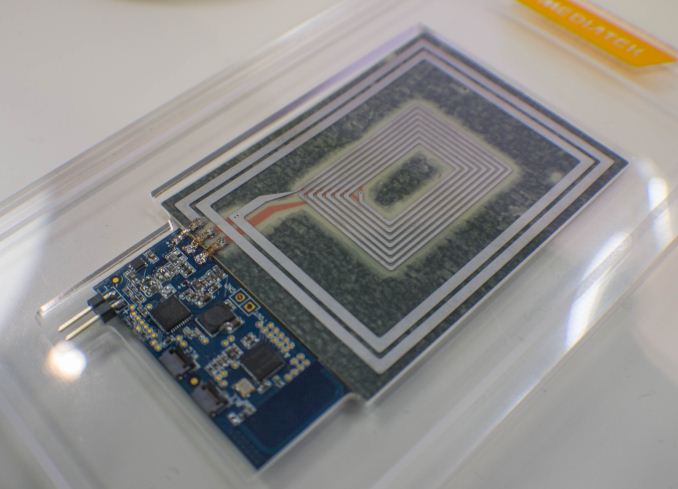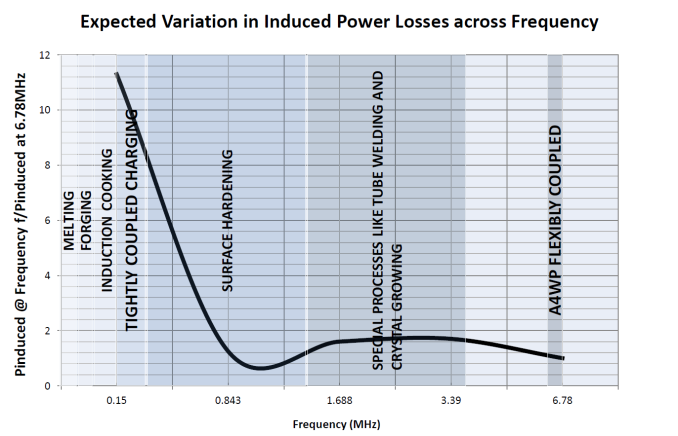The State of Wireless Charging Standards in Mobile
by Andrei Frumusanu on April 2, 2015 8:00 AM ESTRezence Resonance Charging
Earlier we saw the distinction between tightly coupled (TC) and loosely coupled (LC) induction charging systems. While A4WP’s Rezence system is called a magnetic resonance charging system, the basic principle is still based on magnetic induction. The critical difference between Qi and Powermat standards is that it is a Rezence is based on a loosely coupled coil system.
Inductive power frequencies and use-cases (Source)
A4WP systems work on a much higher frequency compared to tightly coupled systems such as defined by PMA and WPC. Rezence’s operating frequency is defined on a strict 6.78MHz (±15kHz) band compared to the 110-357kHz range that Qi and Powermat operate in.
Instead of a tight coil on the transmitter and receivers, we see the usage of a specifically shaped resonator designs. An A4WP transmitter has typically larger footprint than Qi or Powermat designs, with various classes of designs available depending on power requirement. Currently the widely adopted one is the Class 3 transmitter which has a size of 204x146mm and meant for smartphone device use-cases.


A4WP Class 3 spiral type 235-135 power transmit resonator (Source 1, Source 2)
The class system allows A4WP for a variety of size power transmitter unit (PTUs) and power receiving unit (PRUs) resonator coil systems depending on the number of devices and power you are targeting to charge. The class 3 PTU supports up to 16W transmit power.
| PTU Class | Maximum transmission in power |
Minimum PRU Support |
| Class 1 | TBD | >1 x Category 1 |
| Class 2 | 10W | 1 x Category 1, 2, or 3 |
| Class 3 | 16W | 2 x Category 1,2, or 3, or 1 x Category 4 |
| Class 4 | 22W | 3 x Category 1, 2, or 3, or 1 x Category 4 |
| Class 5 | TBD | TDB |
| PRU Category | Maximum reception out power |
Example Applcations |
| Category 1 | TBD | BT headset |
| Category 2 | 3.5W | Feature Phone |
| Category 3 | 6.5W | Smart Phone |
| Category 4 | TBD | Tablet |
| Category 5 | TBD | Laptop |
The current PRU categories are mainly defined for feature phone and smartphone devices with output powers of respectively 3.5 and 6.5W. We should be seeing class 3 devices as the most prevalent category implemented in smartphones in the near future. A class 3 PTU can charge at least two class 3 PRUs at full power, which should be sufficient for most use-cases.
A4WP WPT multi-device charging architecture (Source)
As mentioned before, the LC design of the Rezence charger allows for multiple receivers for a single transmitter, enabling a "star network" of PRUs for each PTU.
While Qi and Powermat respectively use either modulation on the power signal and RFID for communication between the transmitter ans receiver devices, Rezence work with a Bluetooth Low Energy (BLE) connection between all the different actors. There is no device pairing involved as communication is done over GATT (Generic Attribute Profile), a BLE feature.
At MWC2015 multiple vendors were demonstrating their A4WP implementations and chargers, and it was much more impressive to see them in action compared to the TC systems such as Qi and Powermat. Mediatek had a vertically standing Rezence charger which was demonstrated on a Galaxy S4 with custom backplate integrating Mediatek's tri-standard charging solution and powering the device via the dedicated power pins.
Practically, Rezence also seems to be the better solution as one doesn't have to deal with alignment of the device on the charging surface. Charging surfaces can vary in size and have an advantage of reduced complexity as it still remains a single resonator coil, where as Qi requires multiple overlapped coils to achieve the same effect and Powermat doesn't allow such flexibility in the first place.
Closing Thoughts
Having shed a bit more light on the difference and characteristics of the three main charging standard today, the question is on how the future of wireless charging will look. There is an undisputable battle of politics going on between the different standards associations, with each wanting to have their say and their own solutions to the wireless power transfer problem. Though right now the odd man out in all of this is the PMA, as it's hard to argue that Powermat brings any tangible advantages over Qi, not to mention it's a much less widespread standard.
Rezence from the A4WP on the other hand seems to be promising. The A4WP sees tightly coupled systems as first-generation technology that will in the future be replaced by loosely coupled charging implementations such as Rezence. I don't think the lesser charging efficiency will be something that people will mind as the practicality improvements clearly outweigh the disadvantages. The PMA-A4WP merger is seen as a technology swap as the A4WP gains access to a tightly coupled standard and the PMA gets access to a loosely coupled standard.
Meanwhile the WPC is working on its own resonance based loosely coupled system to compete with Rezence, but it's still in the development and we don't yet have much information on it.

MediaTek's tri-standard charging solution demonstration board
IC designers are going forward with tri-standard compatible solutions for wireless charging and that's what I envison will be the the aim for most device manufacturers who will want to include wireless charging into their products. This solves the device compatibility issue, but doesn't solve the problem completely as not all devices will be able to adopt it due to differing form factors. Rezence here again offers the best offering for form factor diversity, power transfer and charger interoperability. Though with the number of factions involved in this battle, it's not necessarily a given that this will be a battle won by technology as opposed to politics.
Ultimately the wireless charging ecosystem has changed a lot over the last few years, and things could again change drastically over the next few years, so nobody knows for sure in which direction the market will shift. We'll be sure to keep an eye on WPT in the future and cover any emerging news on the topic.












90 Comments
View All Comments
retroneo - Friday, April 3, 2015 - link
The 6 and 6 Plus are big enough that they could include both Type-C and lightning. Hopefully they do that at least for a year or two.rtho782 - Friday, April 3, 2015 - link
USB chargers are more common than Qi mats. So, I have one at my desk, one at my bed, one in my car, and it does take 2 seconds, and I can charge my phone while using it, much faster (Qualcomm quick charge).Qi means buying a mat for each of these locations, note that I still need the USB charger to power the mat. It charges slower, it takes up desk space, and if I pick my phone up, it stops charging.
Plugging a USB cable in isn't that much hassle. This is a solution in search of a problem.
uop - Thursday, April 2, 2015 - link
Agree with you about plugging in being a non-issue.However imagine how much sleeker your phone would be without a USB port at all!
mr_tawan - Friday, April 3, 2015 - link
Sony has been releasing phones without usb exposed for quite sometime. It's hidden inside a flap. And if you're using cradle to charge I'd say it's almost 0 needs for using USB. Besides putting phone on the cradle takes almost the same time as using wireless charger (although it can charge only one device at time).I haven't touch the flap on my Z1 for months now (last time I do is to install a custom firmware).
MobiusPizza - Tuesday, April 7, 2015 - link
It's not just about laziness. My Sony Xperia Z is water proof, and getting access to the USB port for chargning is not only a hassle, but repeated opening/closing of the plastc flaps actually reduce the water proof capability to a point the water seal no longer works. A wireless chargning standard enable true water proof phones.mchart - Friday, April 10, 2015 - link
This is why they all have the magnetic charger poets. A $5 adapter on your USB cable and you never have to open the flap. Further, it's easy to use. I'd rather have all phones have magnetic connectors rather then wireless.nandnandnand - Thursday, April 2, 2015 - link
http://www.tomshardware.com/news/ossia-cota-wirele...zodiacfml - Thursday, April 2, 2015 - link
This is what I have been thinking since the first wireless charger. I don't know where I got the idea, maybe from an article that you could get power from Wi-Fi albeit very low power.Anyway, I'd prefer this method as the smartphone is always being charged and could get the power in real time from the wireless signal. It wouldn't need compete with wired charging or any other wireless charging for serious charging as this only lengthens the independence of a device from a charger throughout the day.
Yet, a lower power device might not even need the serious chargers except in emergencies.
Cinnabuns - Thursday, April 2, 2015 - link
Absolutely agree with blanarahul. I never really thought about this issue until I accidentally stumbled upon it. I got a Nexus 4 for myself and my wife at the same time. 2 months in, my wife gave me a Qi charger for my phone, but not for hers. Since then, I've charged my phone everyday with the Qi charger while she charged over USB.At the end of the phones' lives (2 years from purchase), my screen time on my Nexus 4 was an incredibly bad 50 minutes - 1 hour before my battery died. My wife's phone was much closer to 2. (Nexus 4 had pretty mediocre battery life even when it was brand new). My phone was consistently warmer during charging than my wife's phone because of the inefficiency of wireless charging. Those few degrees make a big difference if you value longevity in your batteries.
iamezza - Friday, April 3, 2015 - link
Firstly your sample size is 2 phones, also the phones may have been the same, but the usage of each phone (how much you drain the battery each day) was not controlled.I have a nexus 4 over 2 years and 4 months old and the battery is still good.
Also the Qi charger itself has an effect on the efficiency and heat produced.
Qi works best for certain usage scenarios while USB is better for others.
Wireless is best for keeping your battery topped up during the day while sitting at a desk or while being on the road - you need to put the phone in a dock anyway.
USB is best for when you drain your battery over your daily usage and then just plug it in on the night-stand to give it a full days charge.